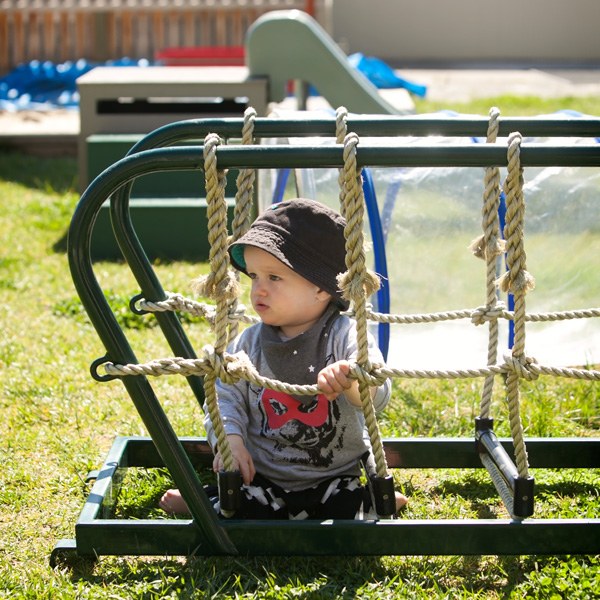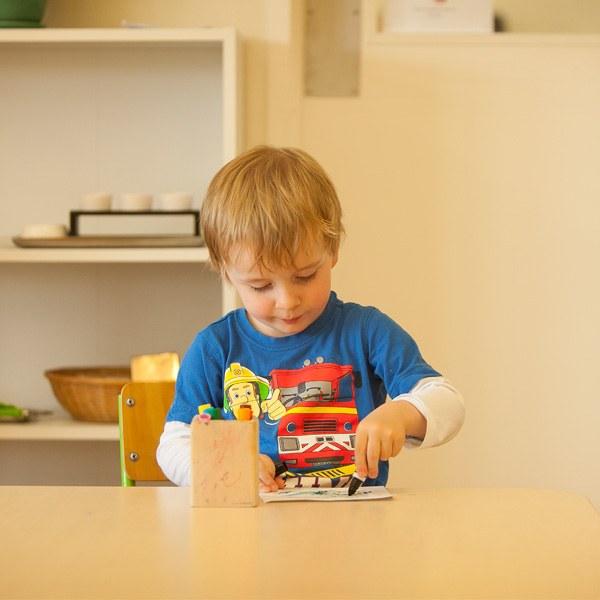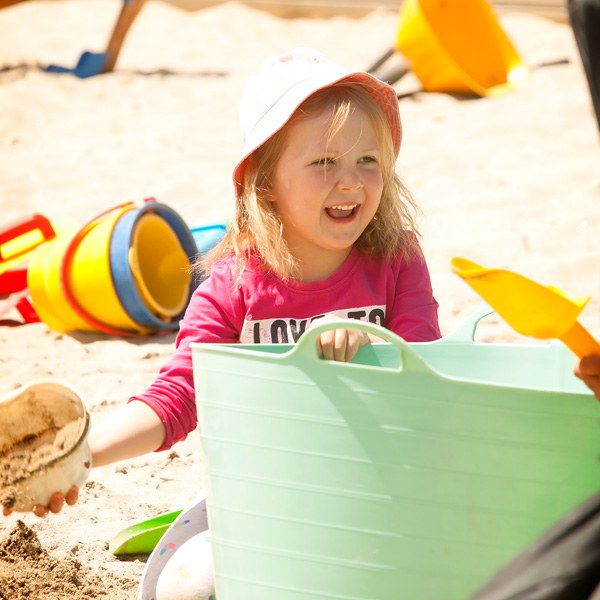Dr Maria Montessori observed that children have distinct planes of development, and that these are in three year age groups. Whilst we generally have rooms that are divided like this with over three year olds in our Casa dei Bambini classroom and under three year olds in our Nido and Young Community classrooms, every child is unique.
In true Montessori style, we follow the child. Under two year olds need to develop skills to feed themselves and drink confidently from a glass, put on their own shoes and hat and sleep on a mattress in preparation for moving into our middle classroom in the Young Community. Children transition into the Casa classroom when they are fully toilet learnt and they are normalised into the Montessori way of working, which includes making independent choices, having sustained concentration and having self-help skills. Moving into the next classroom is never a race, it is taken at the child’s pace.
“Learning is not a race for information, it’s a walk of discovery” - Anon
Our Classrooms

Nido Room (0-2 years)
Our Nido classroom is a very calm environment that doesn’t have a lot of distractions (i.e. pictures and mobiles) on the walls. Babies are in the sensitive period of movement, language and sensorial learning – learning by watching and listening and also putting things in their mouth.
The materials in the classroom are in the same place every day which provides the child with self-regulation and security, knowing that their environment is going to be the same every day.
We focus on freedom of movement so that children can perfect sitting up, crawling and walking. You will frequently find our staff sitting on the floor with our babies, talking to them, reading and working with them by posting items, or digging in the sandpit.
The small ratio of Kaiako to child builds a stronger relationship so the staff know the children and our families well, and we work in unison with the family’s routines. Children who are younger than 9 months will be primary cared with a notebook going home daily for any comments and things arising at home or during the child’s day – sleeping / eating.
Everything in our outside environment is edible including real grass and herbs, so that the children can safely explore their outside world. We have a focus on children learning to be independent by putting on their own shoes, jackets and hat before they go outside.
We are a truly child focused day care centre. You will find that our Nido room is by far one of the cleanest, uncluttered and most homely daycare services available in Hamilton. To ensure this, we hand pick the most nurturing staff that truly love children.

Young Community Room (2-3.5 years)
The Young Community class is where our toddlers to three and a half year olds learn practical life skills – a huge focus for this classroom. Practical life skills are simple daily actions or activities that children need to learn in order to become more independent. This is the age that children want to start doing things for themselves, and it is often a period of frustration - this is no coincidence.
One of the most important building blocks of growing up is what most people call toilet training, however we call this skill toilet learning. It is a skill that must be mastered before moving into our over three year old class where children must be able to toilet independently, and therefore our staff had had specific training on teaching this practical life skill.
Children in the Young Community generally still require an afternoon sleep. They need to learn to be able to help with daily food preparation tasks, serving themselves food, doing their own dishes, putting on their own shoes, hats and jackets. They develop other skills as well, such as gross and fine motor skills, walking on a line, learning to use and then control scissors, how to thread wooden beads and then thread smaller items to make necklaces. The prepared environment (classroom) means that materials in the classroom are in the same place every day which provides the child with self-regulation and security, knowing that their environment is going to be the same every day.
Like in our Casa dei Bambini class (over three year olds), there is only one of every activity which requires children to learn patience and self-direction. They may use the equipment for as long as they like, or feel the need. Once they have finished with it, they return the equipment to the shelf so that someone else can use it. Children also help to sweep and tidy the classroom and wash their own face and hands. They help to cut the fruit for morning tea, set the table at kai time, as well as cleaning up their place setting after them self. They are also developing their language, and so they take great pleasure in having a morning and afternoon circle / mat time in which they sing songs, dance and have stories read to them.
This is a nurturing classroom in which children really start to develop independence, communicate and become what we call “normalised’ – when they can function as part of the community, respecting each other and the equipment, returning it to the shelf again once they are finished with it. Most children transition through to Casa before they turn three and a half years of age.

Casa Dei Bambini Room (3-6 years)
Montessori really starts to shine for most families in our Casa classroom. We are frequently asked when a child will start to do mathematics, or read, things that many Montessori preschoolers do enjoy starting with us, but to answer this truthfully, that we follow Montessori principles here by “following the child” and we operate on their timeframe, not our own.
The role of the Montessori teacher is to observe the children and guide them to new tasks as they move through the curriculum when they can master the tasks they have already been shown. For every piece of work on the shelf, there is a simpler pre-requisite task that will have come before, and a more challenging task that comes afterward.
The practical life skills from the Young Community now develop from dry pouring (beads) to transferring water – this activity requires perfection of movement and fine motor control. More activities include glass - which breaks and therefore teaches natural consequences. It is also a good reason why we wear slippers inside - to protect the feet, but also for good Tikanga Maori to remove shoes when we are inside.
Taking our shoes off before we enter a classroom is demonstrating respect to our classroom, outside shoes are for outside and they are dirty and noisy. Respect is also shown for our tipuna (ancestors) by removing shoes.
Grace and Courtesy lessons are also given in the classroom where we give the child the vocabulary, actions and steps required for them to be a valued member of society; greetings, shaking hands, respecting others, and continuing to use all of the self-help and independence skills that have been learnt in the Young Community.
In this classroom, practical life skills grow into using tweezers for fine motor-skills - also a pencil grip. The children will thread objects, and this eventually develops into sewing. Interest in puzzles demonstrates interest in troubleshooting and potentially mathematics. Everything has an order of learning and in a Montessori classroom, we focus on concrete concepts and activities like counting before we focus on abstract activities like addition and subtraction.
Correct language is important in Montessori because vocabulary is important for literacy. The more vocabulary that a child is exposed to through every day activities, the easier it is for them to learn to read. Curriculum areas also include activities that focus on geography, science, history, art and of course on caring for the outside environment, just like we are expected to do for our inside classroom.
A true Montessori classroom should operate as though the teacher isn’t there, and therefore one thing that you will find when you look into our classrooms during our Montessori work cycle is that our children are all engaged and busy by themselves or with a friend, doing their own work or putting away after themselves. Because the children are all busy, a Montessori school is therefore quiet, clean and tidy. It is this respect for each other and the environment that we strive for - a “normalised” Montessori environment.

